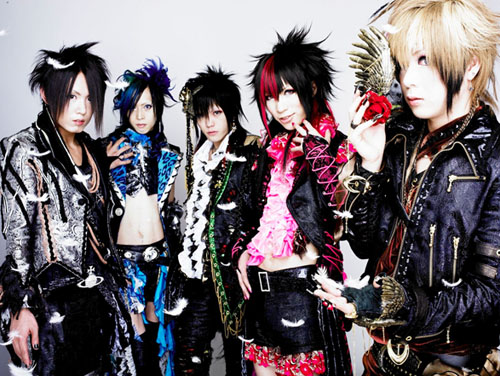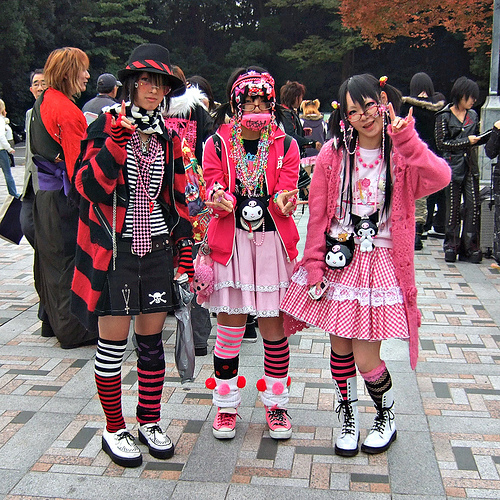Harajuku style gets its name from the spot where the fashion originated, Harajuku station in TokyoJapan, and it is still the place where people wearing Harajuku style gather. There are several different fashions that fall under the Harajuku style: Gothic Lolita, Visual Kei, the ever popular Cosplay, Ganguro, Kogal, Kawaii, and Decora. It is hard to say when exactly Harajuku fashion started, but it became popular and well known during the mid 1990s. This is particularly after the publication of the magazine, FRUiTS, in 1997. The magazine FRUiTS was a monthly publication that ran from 1997 to 2002 and was a collection of photos taken by Shoichi Aoki of the Harajuku style.
Gothic Lolita
Gothic Lolita is the now the most well known of the Harajuku fashion styles. The style can be broken down based on its name. The word "Gothic" refers not to the American Gothic fashion but to the Victorian aristocratic style of dress. This can result in bodice cut dresses which are modest and often have flared cuffs. However, Japanese traditional clothes can also be used. The word "lolita" is given to an adolescent girl. This results in the large amount of lace used on their costumes. Another aspects of the Gothic Lolita style is knee-length dresses or skirts with knee-length socks and platform shoes to match. Usually, these dresses and skirts contain material underneath to make the outfit extend out farther. The common color combination for Gothic Lolita are either all white or black with white lace, however other muted colors can be found. Gothic Lolita girls do not wear a lot of jewelry, rather they wear headbands and gloves that match their outfits and often carry frilly parasols. Jewelry they do wear is likely to Today this style can still be seen on the weekends at Yoyogi park and Jingu Bashi bridge in Harajuku. See More on Gothic Lolitas at: Japanese Subcultures and Gothic Lolitas



Visual Kei
Another style seen at Jingu Bashi bridge, and one closely related to the Gothic Lolita style, is the Visual Kei style. Visual Kei started as a style used by Japanese rock musicians in the 1990's. The goal of Visual Kei music artists was that music could be experienced in a way that is also visual. Visual Kei musicians tend to fall under three types of categories: rock, heavy metal, or punk. Usually Visual Kei musicians combine two or all three of these categories in their work. Like Gothic Lolita style, Visual Kei outfits are usually based on a Victorian style and are often black or muted colors, however these outfits can be accented with bright colors. The main characteristic of the Visual Kei costumes and makeup is to be bold. This leads them to have similar makeup to American Goths due to the heavy use of black, especially around the eyes. Hairstyles are also designed to stand out and usually involves the hair sticking out in various directions. Bleached hair is also very popular among the Visual Kei, because while bleached hair might not be much of a sensation in America, since Japanese all have black hair, other colors attract notice easily. While the Visual Kei style didn't actually originate in Harajuku, it is still considered a Harajuku style because of the many fans of Visual Kei bands who cosplay (dress the same as) their favorite musicians and gather in Harajuku. See more on Visual Kei at Japanese Subcultures




Cosplay
Like Visual Kei, Cosplay is considered part of the Harajuku styles because those wearing the style often turn up there. However, Cosplay different from the other styles because it is much less confined to Harajuku. People who wear Cosplay also have events and shows everywhere in Japan. Cosplay the Japanese shortening of Costume Play. While the term has come to mean dressing up in imitation of a group or person, traditional Cosplay is dressing up in imitation of a manga, anime, or video game characters, much like comic book conventions here in the United States. Also like these conventions here in America, the individuals who choose to dress in this style are commonly referred to as cosplay otaku. Because this dress form is an imitation, there are no rules that set it apart. Some Cosplayers will wear wigs, others will use their own hair, even if it means dying it strange colors. The outfits can be simple, like school girl outfits, or complex fantasy outfits, the requirement is simply to look like and have the same outfit as the character they wish to portray. The outfits and accessories can be bought, however, more often than not the outfits are made, usually by the kids wearing them. See more on Cosplay at: Japanese Subcultures




Kogal and Ganguro
Kogal and Ganguro, are very similar but also distinctly different. The similarities are that both groups tend to have deep tans, bleached hair, and lots of makeup. In fact, Ganguro means "black faced." Also both groups are known for wearing miniskirts. However, while Kogal embraces fashion, the Ganguro style rejects it. Kogal girls are known for sporting designer accessories and latest model cell phones, while Ganguro girls wear bright clothing, platform shoes, and lots of cheap accessories. Kogal girls have been described as Valley girls and some will go on dates (ONLY) for money to help suport their designer spending.The fastest way to distinguish between the groups is to take a look at their make up. The makeup of Kogal girls is heavy to try improve their looks, while the Ganguro girls' makeup is heavy in a completly different way. Ganguro girls wear white eye shadow and lipstick with black eyeliner and fake eyelashes. For this reason the style has been given the nickname panda girls. Also, while both group may bleach their hair, Kogal girls bleach theirs blond but Ganguro girls offen bleach theirs gray or varous shades of orange. See morre about Kogals and Ganguro at: Japanese Fashion
 Kogal Vs Ganguro
Kogal Vs Ganguro

Kawaii and Decora
Like Kogal and Ganguro, Kawaii and Decora are similar. However, while Kogal and Ganguro are distinctive from one another, Kawaii and Decora often converge. Kawaii in Japanese means cute. The Kawaii style involves wearing clothes that small children would wear; this can includes full costumes of cute looking animals and ruffles. The clothes are brightly colored and often feature cute characters like Hello Kitty or Doremon and accessorized with oversize toys or stuffed animals. They don’t tend to wear makeup and their hair styles are those worn by little girls. Decora style, shortened from the English word decoration, also involves dressing up like a child usually with brightly colored clothes which may feature cute characters and toys. However, Decora always involves many layers of clothing and lots of hair accessories, jewelry, and small toys. The makeup tends to be minimal, but they often put stickers or fake rinestones on their faces. Because this was the style most featured in the FRUiTS magazine, it is often mislabeled as FRUiTS style.
Here is a great website for those who want to try to dress Decora.


Japan Versus America
Question: Why to Japanese choose to wear these crazy outfits?
Answer: In a society like Japan's, where individuals are expected not to stand out, it is easy to see how those who need an outlet might choose their clothing as a means of expressing themselves. Harajuku station has become a place where the youth of Japan can express themselves through their clothes while still being part of a group.
Sources
http://wrongresolution.blogspot.com/2009/11/exploring-harajuku-culture.html
http://jrockrae.wordpress.com/about/
http://www.harajukustyle.net/
http://en.wikipedia.org/wiki/Harajuku
http://en.wikipedia.org/wiki/Lolita_Fashion
Comments (0)
You don't have permission to comment on this page.